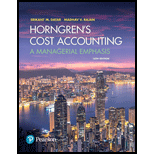
Concept explainers
Direct manufacturing labor variances: price, efficiency, mix, and yield. Elena Martinez employs two workers in her wedding cake bakery. The first worker, Gabrielle, has been making wedding cakes for 20 years and is paid $25 per hour. The second worker, Joseph, is less experienced and is paid $15 per hour. One wedding cake requires, on average, 6 hours of labor. The budgeted direct manufacturing labor quantities for one cake are as follows:
| Quantity | |
| Gabrielle | 3 hours |
| Joseph | 3 hours |
| Total | 6 hours |
That is, each cake is budgeted to require 6 hours of direct manufacturing labor, composed of 50% of Gabrielle’s labor and 50% of Joseph’s, although sometimes Gabrielle works more hours on a particular cake and Joseph less, or vice versa, with no obvious change in the quality of the cake.
During the month of May, the bakery produces 50 cakes. Actual direct
| Gabrielle (140 hours) | $ 3,500 |
| Joseph (165 hours) | 2,475 |
| Total actual direct labor cost | $ 5,975 |
- 1. What is the budgeted cost of direct manufacturing labor for 50 cakes?
Required
- 2. Calculate the total direct manufacturing labor price and efficiency variances.
- 3. For the 50 cakes, what is the total actual amount of direct manufacturing labor used? What is the actual direct manufacturing labor input mix percentage? What is the budgeted amount of Gabrielle’s and Joseph’s labor that should have been used for the 50 cakes?
- 4. Calculate the total direct manufacturing labor mix and yield variances. How do these numbers relate to the total direct manufacturing labor efficiency variance? What do these variances tell you?
Want to see the full answer?
Check out a sample textbook solution
Chapter 7 Solutions
REVEL for Horngren's Cost Accounting: A Managerial Emphasis -- Access Card (16th Edition) (What's New in Accounting)
- Hi expert provide answerarrow_forwardHow much long term debt did the firm have?arrow_forwardWildhorse Windows manufactures and sells custom storm windows for three-season porches. Wildhorse also provides installation service for the windows. The installation process does not involve changes in the windows, so this service can be performed by other vendors. Wildhorse enters into the following contract on July 1, 2025, with a local homeowner. The customer purchases windows for a price of $2,650 and chooses Wildhorse to do the installation. Wildhorse charges the same price for the windows irrespective of whether it does the installation or not. The customer pays Wildhorse $1,988 (which equals the standalone selling price of the windows, which have a cost of $1,230) upon delivery and the remaining balance upon installation of the windows. The windows are delivered on September 1, 2025, Wildhorse completes installation on October 15, 2025, and the customer pays the balance due. (a) Wildhorse estimates the standalone selling price of the installation based on an estimated cost of…arrow_forward
 Cornerstones of Cost Management (Cornerstones Ser...AccountingISBN:9781305970663Author:Don R. Hansen, Maryanne M. MowenPublisher:Cengage Learning
Cornerstones of Cost Management (Cornerstones Ser...AccountingISBN:9781305970663Author:Don R. Hansen, Maryanne M. MowenPublisher:Cengage Learning Managerial AccountingAccountingISBN:9781337912020Author:Carl Warren, Ph.d. Cma William B. TaylerPublisher:South-Western College Pub
Managerial AccountingAccountingISBN:9781337912020Author:Carl Warren, Ph.d. Cma William B. TaylerPublisher:South-Western College Pub Financial And Managerial AccountingAccountingISBN:9781337902663Author:WARREN, Carl S.Publisher:Cengage Learning,
Financial And Managerial AccountingAccountingISBN:9781337902663Author:WARREN, Carl S.Publisher:Cengage Learning,


